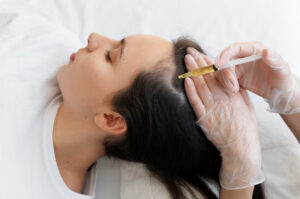PRP Therapy for Hair Growth: A Comprehensive Guide

What is PRP Therapy?
Platelet-rich plasma (PRP) Therapy is a medical treatment that utilizes a concentration of the patient’s own platelets to accelerate healing and promote hair growth. Platelets are a type of blood cell that plays a crucial role in healing and tissue regeneration. PRP is derived from your blood and contains growth factors that stimulate hair follicles, encouraging hair regrowth and improving hair thickness.
How PRP Therapy Can Help You Regrow Hair?
PRP Therapy has shown promising results for individuals experiencing hair thinning and mild to moderate hair loss. The growth factors in PRP can
- Stimulate Dormant Hair Follicles: Encouraging inactive hair follicles to enter the growth phase.
- Improve Hair Thickness: Enhancing the thickness and density of existing hair.
- Reduce Hair Shedding: Minimizing hair loss by strengthening hair roots.
The Procedure of PRP Therapy
The PRP Therapy procedure is relatively straightforward and minimally invasive:
- Blood Collection: A small amount of blood is drawn from the patient’s arm.
- Centrifugation: The blood sample is placed in a centrifuge to separate the platelet-rich plasma from other blood components.
- Preparation: The PRP is collected and prepared for injection.
- Scalp Injections: The PRP is injected into the areas of the scalp experiencing hair thinning or loss. This step is performed using fine needles to ensure precision and minimize discomfort.
Limitations of PRP Therapy
While PRP Therapy can be highly effective, it is essential to understand its limitations:
- Not a Cure-All: PRP may not work for everyone, especially those with advanced hair loss or certain medical conditions.
- Multiple Sessions Required: Achieving optimal results typically requires multiple treatment sessions spaced several weeks apart.
- Maintenance Treatments: Periodic maintenance treatments are often necessary to sustain results.
- Results May Vary: Individual responses to PRP Therapy can vary based on factors such as age, genetics, and the extent of hair loss.
How Hair Transplants Can Help You
For individuals with more significant hair loss or those who do not respond adequately to PRP Therapy, hair transplants can be an effective solution. Hair transplants involve surgically relocating hair follicles from a donor area (usually the back of the scalp) to the thinning or balding areas. This procedure offers several benefits:
- Permanent Results: Transplanted hair follicles are typically resistant to the hormone responsible for hair loss, providing long-lasting results.
- Natural Appearance: Advanced techniques ensure that transplanted hair looks natural and blends seamlessly with existing hair.
- Versatility: Hair transplants can address various types of hair loss, including receding hairlines, bald spots, and thinning crowns.
Conclusion
PRP offers a promising option for those looking to combat hair loss and stimulate hair regrowth. It leverages the body’s natural healing mechanisms to enhance hair thickness and reduce shedding. However, it is essential to understand its limitations and consider alternative treatments, such as hair transplants, for more extensive hair loss. By consulting with a qualified specialist, you can determine the best course of action to achieve your desired hair restoration goals.
Embark on your hair regrowth journey today and discover the benefits of PRP Therapy and hair transplants. Consult with a hair restoration expert to find the most suitable treatment plan tailored to your needs.
